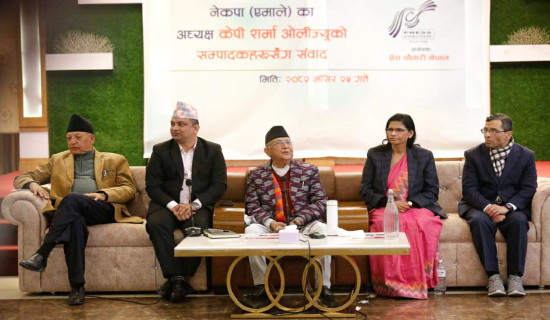- Thursday, 11 December 2025
Lingering air pollution causing eye irritation in capital
Kathmandu, Apr. 9: Sabnam Shrestha, a resident of Bhaktapur, has been experiencing a persistent burning sensation in his eyes for the past few days.
Initially considering a visit to the eye doctor, he hesitated upon learning about the escalating air pollution levels in Kathmandu. Believing his discomfort to be a common consequence of the worsening environmental conditions, he opted against seeking medical attention.
Shrestha, a Pathao rider, thought of temporarily taking a break from his occupation until rainfall clears the air. “My well-being is vital, and I am not bound by any obligations to continue working in these conditions. I can afford to take a few days off for my own well-being.”
In recent days, residents of the Kathmandu Valley have been grappling with a troubling issue; a sharp increase in pollution levels has led to a pervasive burning sensation in their eyes.
This discomfort has become a common concern as reports of forest fires across the nation continue to escalate. The situation has prompted fears about the health impacts of the worsening air quality, compelling residents to seek urgent solutions to mitigate the effects of environmental crisis.
Sundar Sharma, a wildfire expert and under-secretary at the National Disaster Risk Reduction and Management Authority (NDRRMA), disclosed that there were 160 incidents of forest fires in the last 24 hours, primarily concentrated in the Tarai and mid-hill regions.
“Around 70 per cent of the current pollution levels may be attributed to wildfires, with the remaining 30 per cent from other activities,” Sharma explained.
He further cautioned that the peak season for wildfires is yet to come, with the last week of April anticipated to see heightened fire incidents. “If there is insufficient rainfall, the situation could exacerbate, leading to further deterioration of conditions across the country.” He added that wildfire smoke poses serious health risks, including eye problems.
According to the US Air Quality Index (AQI), Kathmandu ranks second only behind Chiang Mai among the most polluted cities in the world on Monday. The AQI for Kathmandu stands at 165. When the AQI exceeds 100, the air is considered unhealthy.
Hasana Shrestha, an environmental inspector at the Department of Environment, noted that during her PhD research she came to know forest fires often impacted the Kathmandu
Valley primarily due to the valley's bowl-shaped structure, surrounded by high hills, which trap heavily polluted air brought by winds from northern India.
According to Shrestha, the Tarai region, including the Chure area, experiences higher pollution levels than Kathmandu due to direct impacts of forest fires. But when winds blow, fires from these regions as well as neighbouring countries are carried into the valley, forming layers of pollution.
Rajan Lamichhane, a senior meteorologist at the Meteorological Forecast Division, said that there is no likelihood of rainfall for another three to four days. He added that the
pollution levels are unlikely to drop until there is substantial rainfall or strong winds, as the pollution in the Valley persists until such weather conditions occur.
“We must remain vigilant about the air pollution warning level because the western winds carry smoke from neighboring countries, mainly India, which becomes trapped within the Valley,” he added.
















